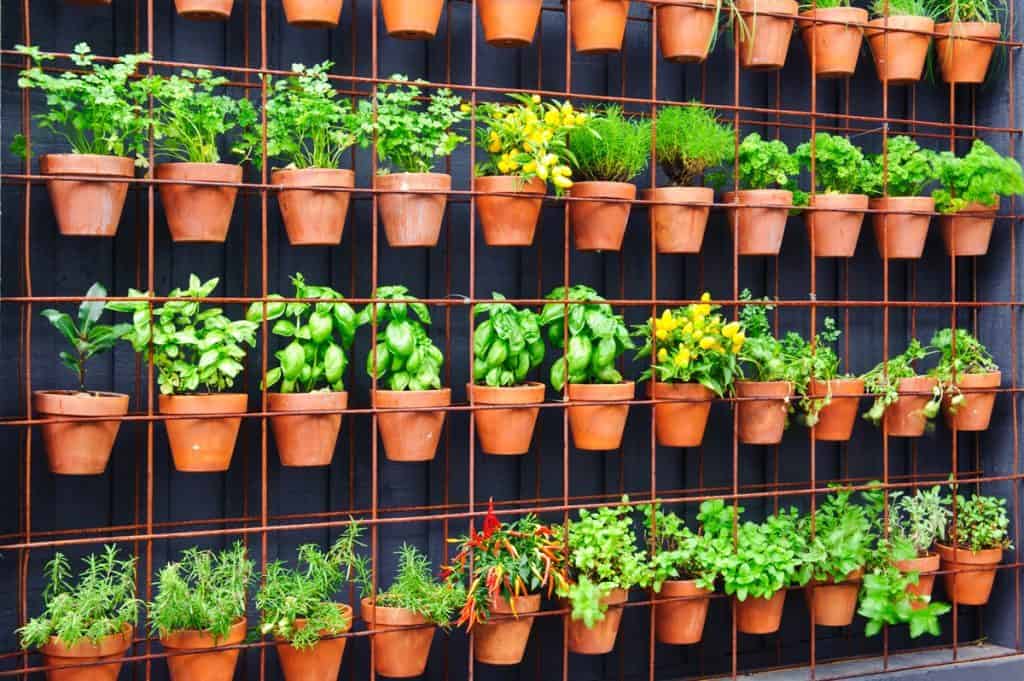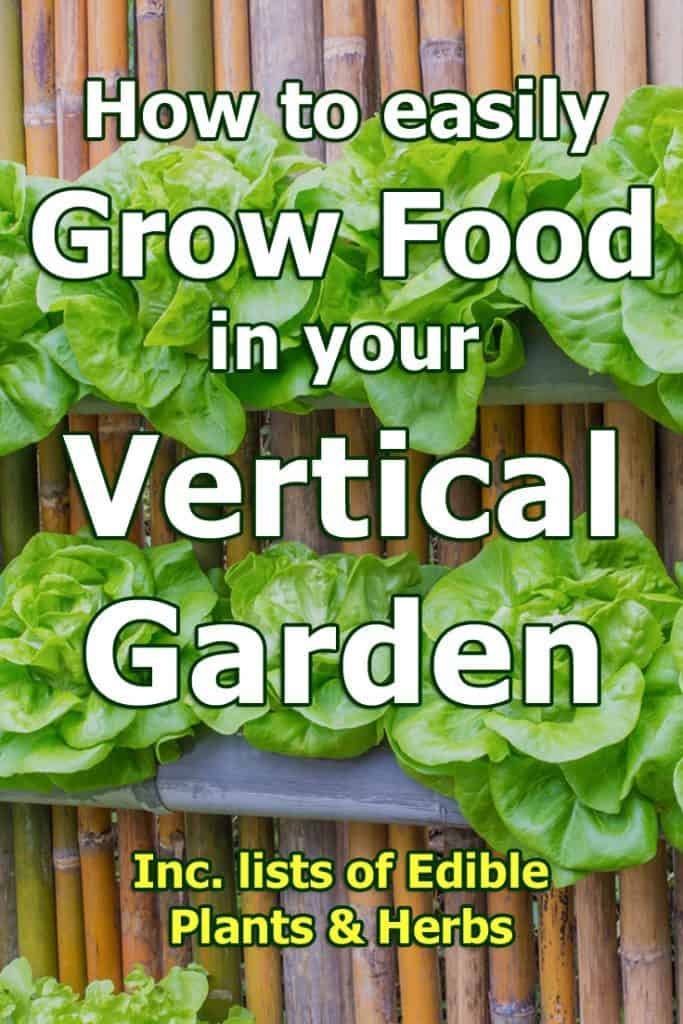Growing food in a vertical garden exploits one of the very best things about the work and care of any vertical garden. What in the world could be better than munching down on our own delicious vegetables and herbs?
Vertical gardens are great for growing edible plants. They offer unique and superior conditions for food growing because they are raised and not connected to the ground. You do need to choose the right spot, with the right amount of light/shade ratio, offer the plants water, good soil and fertilizer and voila!
Great edible food plants to grow in your vertical garden include -
- Lettuces
- Peppers
- Cherry tomatoes
- Chives
- Onions
- Pretty much any type of herb (we'll elaborate on those later).
Keep reading as we investigate the ins and outs of growing food in a vertical setup and how to choose the best plants for your live vertical pantry. More detailed lists are coming - brace yourself!
Why growing food in a vertical garden so practical?
As a gardener, the vertical garden gives you a highly-controlled setup, especially when done indoors (but not only). With the plants growing in containers, you control the soil, watering system, fertilizers, and pest control.
And this is fantastic for growing your food. Here's why.
For those who have been living under a rock, today's agricultural practices in commercial setups often result in food that's less healthy for us to eat. Pesticides, herbicides, and fertilizers can form a truly unhealthy chemical stew at the very basis of our food chains. Irresponsible practices can harm us, in short.
Obviously, most foods we buy are just fine. But the many warnings we see advising us to never fail to wash off our vegetables and fruits speak volumes.
Indeed, this is one of the reasons home gardening is reaching a new height of popularity. We may never replace all the vegetables and fruits we eat with our own products, but we can most assuredly monitor what steps we take towards finally harvesting the healthiest food we can.
Vertical gardening gives anyone the opportunity to grow their own food. As we'll elaborate on later in this post, it requires less floor/ground space. Which means anyone can grow their own little vertical garden - even inside an urban apartment.
That means you can create your own pesticide-free zone, or at least have better control on the amounts used when growing your own vegetables.
The special case for growing herbs in your vertical garden
And for those who enjoy the garnishings and flavors offered by herbs and spices, vertical gardening brings great news. In commercial farming, leafy vegetables, including herbs, get the largest amount of pesticide. That's done to make sure bugs won't be able to hide among the leaves and keep on living. It's just not that healthy for us.
Also, spices and herbs have seriously spiked in terms of price. The packaging alone costs real money, much less storage and aging in commercial farm factories.
The great news is that most herbs are easy to grow and occupy so little space they make perfect vertical garden plantings. Planting 6-10 varieties of spice herbs in a small vertical garden is completely doable.
Even if you're an inexperienced gardener and live in an apartment, give a small herb vertical garden a try - you're going to love the results!

Backyard Farming - The Vertical Way
So, how about larger scale vertical gardening of food? What kind of crops can you go for?
The concept of backyard farming is pretty much an urban construct.
Needless to say, on farms a "backyard farm" is the total land around a home. In other words, it is a nonexistent concept.
In cities and towns, the land around our homes is so much more proscribed. Backyards are bordered and small. It is reasonably easy to predict home lots in major cities will tend to be in the neighborhood of about 60 feet wide and, maybe 90-100 feet deep. This definitely reduces the footprint onto which we can garden.
"Front-yard food gardens" are basically nonexistent. The focus out front, instead, is the welcoming landscaped face of a home and a pleasant face to welcome and also to enhance the worth of an entire neighborhood. So, in the end, we look at our backyards for our more private projects. Growing food is one of them.
Homeowners with the urge to garden for flowers or food can thereby tackle their pet projects, work away from the madding crowd in the solitude that we all need. So they diligently work and re-work the soil and plant and harvest, to encourage the absolute maximum out of their small plots. And some are exceptionally good at it too.
However, these projects are also limited by lot size. Just because we speak of an 'average lot" does not mean they are all large enough for tractors and garden machines. They simply are not, and some are the postage stamp size.
That's why vertical gardening offers an exceptionally rich addition to backyard garden possibilities. Vertical gardens occupy less horizontal ground because everything that happens in them is raised. It all takes place on a small footprint but it still allows an enormous amount of harvestable plants.
What kinds of food can we not grow in a vertical garden?
We can readily see what advantages vertical gardens have over those on the ground in the sense that we can so customize their environments. We can optimize air circulation, feeding, and watering. It is possible also to provide the maximum or minimum sun exposure.
So where are the limitations? What edible plants do best in vertical gardens?
The 2 caveats in food-growing in a vertical garden:
- The plant's overall weight
- Root size
As structurally substantial as a vertical garden may be, it will still have limitations in weight and girth. This does not mean we can only grow tiny plants which don't gain weight while growing. It also does not necessarily mean we have to omit the heavier melons, squashes, tomatoes beans or any other plants. It just means we have to design them to take these factors into consideration.
How Are Heavy Plants Possible To Grow in a Vertical Garden?
The design is everything.
Choosing the plants to cultivate in a vertical garden will also involve placement considerations. It would be ridiculous to place vining plants at the top of a vertical garden unless we wanted the inevitable and quite extensive vines either cascading down the front or else climbing further above.
You should, therefore, place the heavy vining plants at the bottom of a vertical wall of planters. So, yes, possible to grow heavy food plants in a vertical garden but keep them at the bottom of the stack, or the middle part at most.
Assessing the root range of your food plants
Another consideration concerns the eventual root range of plants. Obviously, this applies specifically to vegetables which thrive and mature undergrounds, such as potatoes, beets, carrots, and various legumes.
While large containers can enable the growth of these plants, that is not a typical vertical garden construction. If you absolutely must try your hand at growing potatoes, take care to get very wide and stable containers and again, place them at the bottom of the vertical garden layout.
Best Foods to grow In Vertical Gardens
Now it's getting exciting.
The range of possible foods a vertical garden can produce is incredibly wide.
- Lettuces and all sorts of delicious salad makings are perhaps the easiest and quickest to harvest.
- Radishes grow quickly and often mature within 45 days.
- Seed cabbages make excellent vertical garden plants.
- Chives and small green onions grow quickly as well.
- Tomatoes whose viney growth cascade down such as grape tomatoes and the smaller varieties make colorful and delicious vertical garden plants.
- The larger more viney plants such as melons or squash can be housed near the bottom so as to trail their vines. Often gardeners train them up poles or edifices constructed nearby to grow them upwards.
- Beans of all types fit this bill as well.
- Strawberries are a personal favorite. Varieties of strawberries have been hybridized to fulfill perfectly the goals of vertical gardens as well as those of suspended container gardens. Like all robust growers, they require frequent feedings, but the color of the blooms and berries make a gorgeous spectacle in the middle of all that other growth.
Since we mentioned melons and other vines and climbers. Many people attribute these poles and climbing structures to "vertical gardening", which is, in a sense true. But it's worth noting that the basis of these plants is anything but vertical. They are either in the local soil or a container close to the ground.
What About Herbs?
Back to the herb garden. Let's briefly give you some ideas of what you can grow in your little vertical herbr garden. The list of herbs that can grow and thrive in a vertical garden is literally off the charts.
Most popular herbs are plants which tend to mature quickly and which require pretty low levels of stress. Imagine picking some basil right off of plants just outside the kitchen door. Or garnishing a meal with your own parsley.
Here's a quick (and partial) list of herbs which would work well in any vertical garden - large or small:
- Parsley
- Basil
- Lavender
- Mints of all kinds (much more controllable with a limited root base),
- Sorrel
- Rosemary
- Thyme
- Small green onions
- Chives
- Cilantro
- Dill
- Lemon Balm
- Sage
Growing herbs is also a perfect way to save some money, as mentioned above. But the true bottom line in growing herbs is the discovery that your own simply taste better. Ask anyone who has taken the leap into vertical gardening of herbs and vegetables. The purity and wholesomeness are astounding. It can be as if you were biting into some strange but delicious new food.
Summary
In vertical gardens, the inventor/gardener controls everything - the soil, the sun, the water, and feeding. As experience grows, so will the gardener's library of tactics and choices.
Those who have harvested what their vertical garden produced all speak highly not just of the experience of "growing your own". They will also have invented their private personal construction which happens to deliver purity and great health.
The taste is terrific and so is the pride and value of knowing exactly what you're doing. Growing veggies and herbs in vertical gardens is not only healthful, but it is also completely rewarding. After all, you got to stay close to your plants at eye level, face to face. They become more than just food.
And if you can, please pin this post to your Pinterest account to share with others - thank you!

